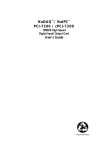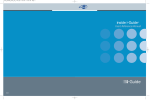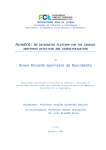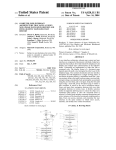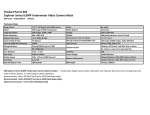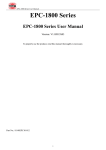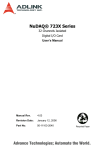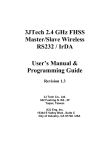Download NuDAQ® PCI-7256 User's Guide
Transcript
NuDAQ PCI-7256 Latching Relay Actuator & Isolated D/I Cards User’s Guide Recycled Paper ©Copyright 2001 ADLINK Technology Inc. All Rights Reserved. Manual Rev : 1.00 December 11, 2001 Part NO : 50-11127-100 The information in this document is subject to change without prior notice in order to improve reliability, design and function and does not represent a commitment on the part of the manufacturer. In no event will the manufacturer be liable for direct, indirect, special, incidental, or consequential damages arising out of the use or inability to use the product or documentation, even if advised of the possibility of such damages. This document contains proprietary information protected by copyright. All rights are reserved. No part of this manual may be reproduced by any mechanical, electronic, or other means in any form without prior written permission of the manufacturer. Trademarks NuDAQ is registered trademarks of ADLINK Technology Inc. Other product names mentioned herein are used for identification purposes only and may be trademarks and/or registered trademarks of their respective companies. Getting service from ADLINK ♦ Customer Satisfaction is always the most important thing to ADLINK. If you need any help or service, please contact us. ADLINK Technology Inc. Web Site http://www.adlinktech.com Sales & Service [email protected] w Technical NuDAQ + USBDAQ [email protected] Support Automation [email protected] NuIPC [email protected] NuPRO/EBC [email protected] TEL +886-2-82265877 FAX +886-2-82265717 9F, No. 166, Jian Yi Road, Chungho City, Taipei, 235 Address Taiwan ♦ Please inform or FAX us of your detailed information for a prompt, satisfactory and constant service. Detailed Company Information Company/Organization Contact Person E-mail Address Address Country TEL FAX Web Site Questions Product Model OS Computer Brand M/B: CPU: Environment to Use Chipset: BIOS: Video Card: Network Interface Card: Other: Challenge Des cription Suggestions to ADLINK Table of Contents Chapter 1 Introduction ............................................................. 1 1.1 1.2 1.3 1.4 Features ................................................................................. 2 Applications ............................................................................ 2 Specifications ......................................................................... 3 Software Support .................................................................... 5 1.4.1 1.4.2 1.4.3 1.4.4 1.4.5 1.4.6 1.4.7 1.4.8 Programming Library.........................................................................5 ® PCIS-LVIEW: LabVIEW Driver......................................................5 PCIS-VEE: VEE Driver......................................................................6 PCIS-OCX: ActiveX Controls............................................................6 PCIS-DDE: DDE Server and InTouchTM.........................................6 PCIS-ISG: ISaGRAFTM driver...........................................................6 PCIS-ICL: InControlTM Driver............................................................7 PCIS-OPC: OPC Server....................................................................7 Chapter 2 Installation................................................................ 8 2.1 2.2 2.3 2.4 2.4 2.5 2.6 2.7 What you have........................................................................ 8 Unpacking .............................................................................. 9 PCB Layout .......................................................................... 10 Jumper Setting ..................................................................... 11 External LED connection ....................................................... 12 Board ID............................................................................... 13 Connector Pin Assignments................................................... 14 Termination Board Connection............................................... 15 Chapter 3 Register Format ....................................................16 3.1 3.2 3.3 3.4 3.5 3.6 3.7 3.8 3.9 I/O Address Map ................................................................... 16 Relay Output Control Register ............................................... 17 Relay Output Read Back Register .......................................... 18 Isolated Digital Input Register ................................................ 18 COS Setup Register.............................................................. 19 COS Latch Register .............................................................. 19 Interrupt Control Register ...................................................... 20 Interrupt Status Register........................................................ 22 Handling PCI Controller Registers .......................................... 22 Chapter 4 Operation Theorem ..............................................24 4.1 Latching Relay Output ........................................................... 24 Table of Contents • i 4.2 4.3 4.4 Isolated Digital Input .............................................................. 26 Interrupt Architecture............................................................. 27 Change of State(COS) Interrupt ............................................. 27 Chapter 5 C/C++ DOS Libraries ...........................................28 5.1 Programming Guide .............................................................. 28 5.1.1 5.1.2 5.2 5.3 5.4 5.5 5.6 5.7 5.8 5.9 5.10 Naming Convention ....................................................................... 28 Data Types....................................................................................... 29 _7256 Initial .......................................................................... 30 _7256_DO............................................................................ 31 _7256_DO_Read_Back......................................................... 31 _7256_DI ............................................................................. 32 _7256_COS_Channel ........................................................... 33 _7256_COS_Latch................................................................ 33 _7256_INT_Control ............................................................... 34 _7256_CLR_IRQ .................................................................. 35 _7256_GET_IRQ_Status ....................................................... 35 Appendix A. Relay Contact Protection Circuits .......36 Warranty Policy ........................................................................39 ii • Table of Contents How to Use This Guide This manual is for helping users to manipulate the PCI-7256. It is divided into 5 chapters. • Chapter 1, Introduction, gives an overview of the product features, applications, and specifications. • Chapter 2, Installation, describes how to install the PCI-7256. The layout of PCI-7256 is shown, and jumper setting for digital input filter, external LED connection and Board ID switch are specified. The connectors’ pin assignments are also described. • Chapter3, Register Format, describes the details of register format and structure of the PCI-7256. This information is very important for the programmers who want to control the hardware by low level programming. • Chapter 4, Operation Theorem, describes how to operate the PCI7256. The latching relay, isolated digital input and change-of-state functions are introduced. Some programming concepts are also described. • Chapter 5, C/C++ libraries, describes the software utility and the library of PCI-7256, and also describes how to meet your requirements and help you to program your own software application. • Appendix A, relay Contact Protection Circuits, provides the information about relay contact protection circuits. How to Use This Guide • iii 1 Introduction The PCI-7256 Latching Relay Actuator and Isolated D/I card is a basic Digital I/O card for PCI bus computer in industrial applications. This PCI-7256 provide 16 latching relay actuators and 16 opto-isolated digital inputs. All relays are Form C type. They are very suitable for ON/OFF control devices. All of the digital input channels are identical non-polarity opto-isolated, each of them can be switchable by using RC filter or non-RC filter. All channels are isolated and suitable for collecting digital inputs in noisy environments. The function of “Change-of-State” (COS) interrupt is provided. It means when any of these digital inputs changes its state, an interrupt will be generated for user to handle this external event. Using latching relays, the PCI-7256 has the advantage of power saving. The status of each latching relay output is reflected by a LED. When the latching relay is in SET condition, its corresponding in-board LED will turn ON, otherwise it is OFF. Another useful feature is Board ID. It’s convenient for user to identify a specified card by setting up a switch when user have two or more PCI-7256 cards in one system. The I/O signals are via a 68-pin SCSI connector. Introduction • 1 1.1 Features The PCI-7256 Latching Relay Actuator and D/I Card provides the following advanced features: 1.2 • 32-bit PCI-Bus, Plug and Play • 16 latching relay actuator outputs, the output status will remain when power-off • 16 opto-isolated digital inputs for PCI-7256 • LED indicators to show the status of relays and can be read back • Jumper selectable AC-filtered/non-AC-filtered input signals • On-board relay driving circuits • Change-of-State (COS) detection for digital input channels • Digital input channel 0 & 1 interrupt • Dry contact input available • Board ID Applications • Industrial ON/OFF control • External high power relay driving, Signal switching • Laboratory automation • Industrial automation • Switch contact status sensing, lim it switch monitoring, • Cooperating with A/D and D/A cards to implement a data acquisition & control system 2 • Introduction 1.3 Specifications ♦ Digital input Input channels Photo-coupler Input current Input Voltage Input impedance Input mode Isolated voltage 16 PC-3H4 10 mA rated 50 mA max. for isolated input Up-to 24 V DC or 24V AC Logic Low: 0~2V Logic High 5~24V 4.7 KΩ Isolation AC-filter/ Non-AC-filter 2,500 Vrms channel-to-system ♦ Relay Output Output channels Relay type Contact rating Breakdown voltage Release time Operate time Contact resistance Insulation resistance Life expectancy (min. operations) Vibration Resistance LED indicators Power supply of Relay 16 16 DPDT ( Form C ) 125V AC , 0.5 A 30V DC, 1A 1000 V rms 3 msec 3 msec 60mΩ 1000M Ω min. (at 500 V DC) > 2 X 105 times at 1A 30V DC > 105 times at 0.5A 125V AC 176.4m/s 2(18G), 10 to 55Hz at double amplitude of 3mm Monitor SET/RESET status of each relay; external LED connectors could be applied + 5V from the PCI-Bus ♦ Isolated +5V Power Supply Output Voltage Output Current +5V 170mA max. (@ 40°C) ♦ General Specifications Dimension Bus Operating temperature Storage temperature 174 mm x 106 mm, standard PCI half size 32-bit PCI bus 0 ~ 60 °C -20 °C ~ 80 °C Introduction • 3 Humidity 5 to 95% non-condensing ♦ Power Consumption PCI-7256 4 • Introduction +5V @ 340 mA (No relays energized) 980mA maximum when all relays are active simultaneously 1.4 Software Support ADLINK provides versatile software drivers and packages for users’ different approach to built-up a system. We not only provide programming library such as DLL for many Windows systems, but also provide drivers for many ® TM TM TM software packages such as LabVIEW , VEE , InTouch , InControl , TM ISaGRAF , and so on. All the software options are included in the ADLINK CD. The non-free software drivers are protected with serial licensed code. Without the software serial number, you can still install them and run the demo version for two hours for demonstration purpose. Please contact ADLINK or the dealer to purchase the software license serial code. 1.4.1 Programming Library For customers who are writing their own programs, we provide function libraries for many different operating systems, including: • DOS Library: Borland C/C++ and, the functions descriptions are included in this user’s guide. • PCIS-DASK: Include device drivers and DLL for Windows 98, Windows NT and Windows 2000. DLL is binary compatible across Windows 98, Windows NT and Windows 2000. That means all applications developed with PCIS-DASK are compatible across Windows 98, Windows NT and Windows 2000. The developing environment can be VB, VC++, Delphi, BC5, or any Windows programming language that allows calls to a DLL. The user’s guide and function reference manual of PCIS-DASK are in the CD. Please refer the PDF manual files under \Manual_PDF\Software\PCISDASK. The above software drivers are shipped with the board. Please refer to the “Software Installation Guide” to install these drivers. 1.4.2 ® PCIS-LVIEW: LabVIEW Driver PCIS-LVIEW contains the VIs, which are used to interface with NI’s ® LabVIEW software package. The PCIS-LVIEW supports Windows ® 95/98/NT/2000. The LabVIEW drivers are free and shipped with the board. You can install and use them without license. For detail information about PCIS-LVIEW, please refer to the user’s guide in the CD. (\Manual_PDF\Software\PCIS-LVIEW) Introduction • 5 1.4.3 PCIS-VEE: VEE Driver The PCIS-VEE includes the user objects, which are used to interface with VEE software package. PCIS-VEE supports Windows 95/98/NT/2000. The VEE drivers are free and shipped with the board. You can install and use them without license. For detail information about PCIS-VEE, please refer to the user’s guide in the CD. (\Manual_PDF\Software\PCIS-VEE) 1.4.4 PCIS-OCX: ActiveX Controls We suggest the customers who are familiar with ActiveX controls and VB/VC++ programming use PCIS-OCX ActiveX control components library for developing applications. PCIS-OCX is designed for Windows 98/NT/2000. For more detailed information about PCIS-OCX, please refer to the user's guide in the CD. (\Manual_PDF\Software\PCIS-OCX\PCIS-OCX.PDF) The above software drivers are shipped with the board. Please refer to the “Software Installation Guide” in the package to install these drivers. Also ADLINK supplies an ActiveX control software DAQBench. DAQBench is a collection of ActiveX controls for measurement or automation applications. With DAQBench, you can easily develop custom user interfaces to display your data, analyze data you acquired or received from some other sources, and integrate with popular applications or data sources. For more detailed information about DAQBench, please refer to the user's guide in the CD. (\Manual_PDF\Software\DAQBench\DAQBenchManual.PDF) You can also get a free 4-hour evaluation version of DAQBench from the CD. DAQBench is charged software. Please contact ADLINK dealer or ADLINK to purchase the software license. 1.4.5 TM PCIS-DDE: DDE Server and InTouch DDE stands for Dynamic Data Exchange specifications. The PCIS-DDE includes the PCI cards’ DDE server. The PCIS-DDE server is free and included in the ADLINK CD. The DDE server can be used conjunction with any DDE client under Windows 98/NT/2000. 1.4.6 PCIS-ISG: ISaGRAF TM driver The ISaGRAF WorkBench is an IEC1131-3 SoftPLC control program development environment. The PCIS-ISG includes ADLINK products’ target 6 • Introduction drivers for ISaGRAF under Windows NT environment. The PCIS-ISG is included in the ADLINK CD. It needs license. Please contact ADLINK or dealer to purchase the license. 1.4.7 TM PCIS-ICL: InControl Driver PCIS-ICL is the InControl driver which support the Windows NT. The PCISICL is included in the ADLINK CD. It needs license. Please contact ADLINK or dealer to purchase the license. 1.4.8 PCIS-OPC: OPC Server PCIS-OPC is an OPC server, which can link with the OPC clients. There are many software packages on the market can provide the OPC clients now. The PCIS-OPC supports the Windows 98, NT, and 2000. Please contact ADLINK or dealer to purchase the license. Introduction • 7 2 Installation This chapter describes how to install the PCI-7256. The contents in the package and unpacking information that you should be careful are described. 2.1 What you have In addition to the User’s Manual, the package includes the following items: • PCI-7256 latching relay and digital input cards • ADLINK Software CD • Software Installation Guide If any of these items is missing or damaged, contact ADLINK or the dealer from whom you purchased the product. Save the shipping materials and carton in case you want to ship or store the product in the future. 8 • Installation 2.2 Unpacking Your PCI-7256 card contains sensitive electronic components that can be easily damaged by static electricity. The card should be operated on a grounded anti-static mat. The operator should be wearing an anti-static wristband, grounded at the same point as the anti-static mat. Inspect the card module carton for obvious damage. Shipping and handling may cause damage to your module. Be sure there are no shipping and handling damages on the module before processing. After opening the card module carton, extract the system module and place it only on a grounded antistatic surface with component side up. Again inspect the module for damage. Press down on all the socketed IC's to make sure that they are properly seated. Do this only with the module place on a firm flat surface. Note : DO NOT APPLY POWER TO THE CARD IF IT HAS BEEN DAMAGED. You are now ready to install your PCI-7256. Installation • 9 2.3 PCB Layout The location of connector, switch and jumpers are shown in the figure2.1. They are described in the following sections. CN1 JP2 JP1 S1 JP4 JP3 Figure 2.1 PCI-7256 PCB Layout 10 • Installation 2.4 Jumper Setting The PCI-7256 is a ‘plug and play’ add-on card for PCI bus. It is not necessary for user to setup its base address and IRQ level to fit the hardware of your computer system. However, to fit user’s versatile operation, there are still a few jumpers to set for the digital input. The jumpers on PCI-7256 card are used to configure the digital input channels as AC-Filtered or Non-AC-Filtered inputs. Each digital input channel and their corresponding jumpers are shown in the following Table2.1. JUMPER JP1 JP2 INPUT SIGNAL DI0 ~ DI7 DI8 ~ DI15 Table 2.1 The jumpers and DI channels The default setting of the input signal selection is Non-AC-Filtered ( DC signal input), which is shown as below : Figure 2.2 Default Input Signal Jumper Setting Installation • 11 2.4 External LED connection Figure 2.3 External LED connectors for relay status indication The PCI-7256 card has 16 LEDs on board to indicate the operation status of the 16 relays. In addition, PCI-7256 also has 16 external LED connectors for users’ applications. Utilizing external LEDs connecting with the JP3 and JP4, users can have their relays status shown on chassis ,panel or other apparatus. Only LED which have fordward voltage (Vf) lower than 3V can work normally. Each external LED connector has a current limiting resistor (330O ) connecting with +5V power, so it’s not necessary for user to add a resistor to limit the current flow through LED. The direction of the external LED’s connection is shown in Figure 2.3. Before connect user’s LEDs on these connectors, make sure the LED is in the right direction. 12 • Installation 2.5 Board ID When users plug two or more data acquisition cards in one system, it takes a lot of efforts to identify one specific card. For easier identification, PCI-7256 provides a Board ID function. According to a DIP switch configuration located in S1, users can assign a board ID to a specific card directly and access the card correctly through software programming. For more details about Board ID in programming, please refer to chapter 5. Table 2.2 shows all of the switch setting conditions. ON 1 2 3 4 Figure 2.4 Board ID setting Board ID 0 1 2 3 4 5 6 7 8 9 10 11 12 13 14 15 Switch No. 1 2 3 4 1 0 1 0 1 0 1 0 1 0 1 0 1 0 1 0 1 1 0 0 1 1 0 0 1 1 0 0 1 1 0 0 1 1 1 1 0 0 0 0 1 1 1 1 0 0 0 0 1 1 1 1 1 1 1 1 0 0 0 0 0 0 0 0 Note: 1=on, 0=off Table 2.2 Board ID Setting Conditions Installation • 13 2.6 Connector Pin Assignments The PCI-7256 card is equipped with a 68-pin SCSI connector (CN1). The pin assignment of the SCSI connector is described by Figure 2 .5. ISO5V DI0 DI2 DI4 DI6 DICOM2 DI8 DI10 DI12 DI14 NC0 COM0 NO0 NC1 COM1 NO1 NC2 COM2 NO2 NC3 COM3 NO3 NC4 COM4 NO4 NC5 COM5 NO5 NC6 COM6 NO6 NC7 COM7 NO7 1 2 3 4 5 6 7 8 9 10 11 12 13 14 15 16 17 18 19 20 21 22 23 24 25 26 27 28 29 30 31 32 33 34 35 36 37 38 39 40 41 42 43 44 45 46 47 48 49 50 51 52 53 54 55 56 57 58 59 60 61 62 63 64 65 66 67 68 ISOGND DI1 DI3 DI5 DI7 DICOM1 DI9 DI11 DI13 DI15 NC8 COM8 NO8 NC9 COM9 NO9 NC10 COM10 NO10 NC11 COM11 NO11 NC12 COM12 NO12 NC13 COM13 NO13 NC14 COM14 NO14 NC15 COM15 NO15 Figure 2.5 Pin Assignment of PCI-7256 CN1 Legend : DI x DICOM x ISO5V ISOGND NO x COM x NC x : Digital input channel x, x= 0~15 : DI common ground group x, x=1 for DI channel 0~7, x=2 for DI channel 8~15 : Isolated 5V power output : Isolated ground for +5V power output : Normal Open pin of relay x, x=0~15 : Common pin of relay x, x=0~15 : Normal Close pin of relay x, x=0~15 14 • Installation 2.7 Termination Board Connection The PCI-7256 is equipped with a SCSI 68-pin connector. The available termination board is DIN-68S/1S. The DIN-68S/1S is a general purpose 68 pin screw terminal with DIN socket. It is also equipped with a SCSI-68 pin cable that makes users install PCI-7256 more easily. Installation • 15 3 Register Format The detailed descriptions of the register format are specified in this chapter. This information is quite useful for the programmers who want to handle the card by low-level programming. However, we suggest user understand more about the PCI interface before starting low-level programming. 3.1 I/O Address Map The 7256 registers are all 16-bit wide. Users can access these registers only by 16 bits I/O instructions. The control of the relays and status of the isolation input is by means of accessing registers. The following table shows the register map, including descriptions and their offset addresses relative to the base address. Table 3.1 The register map of PCI-7256 Offset Write Read 0x00h Relay Output CH. 0~7 -- Relay Output CH. 8~15 Relay Output Read back CH.0~15 0x04h --- Isolated Input CH. 0~15 0x06h COS Setup Register COS Latch Register 0x08h Interrupt Control Register Interrupt Status Register 0x02h 16 • Register Format 3.2 Relay Output Control Register There are 16 latching relays on each PCI-7256 board. Each latching relay is controlled by two bits of the control register. The setting (0,1) means the latching relay is in RESET condition. Under the RESET condition, the normal open(NO) signal line is ‘open’ from the common(COM) line and the normal close(NC) signal line is connected with the common line. The setting (1,0) means the normal open signal line is now closed, while the NC signal is open. For safety operation, do not fill the register with (1,1) or it will cause an uncertain output status of the relay. For more information about the latching relay and software function library, please refer to section 4.1 and 5.3, respectively. Address: BASE + 0x00 Attribute: Write 7 6 DO3_S 15 DO7_S DO3_R 14 DO7_R 5 4 3 2 1 0 DO2_S 13 DO6_S DO2_R 12 DO6_R DO1_S 11 DO5_S DO1_R 10 DO5_R DO0_S 9 DO4_S DO0_R 8 DO4_R 4 DO10_R 12 DO14_R 3 DO9_S 11 DO13_S 2 DO9_R 10 DO13_R 1 DO8_S 9 DO12_S 0 DO8_R 8 DO12_R Address:BASE + 0x02 Attribute: Write 7 DO11_S 15 DO15_S 6 DO11_R 14 DO15_R 5 DO10_S 13 DO14_S DOx_R: Reset bit of relay output channel x, x=0~15 DOx_S: Set bit of relay output channel x, x=0~15 Register Format • 17 3.3 Relay Output Read Back Register The status of the latching relay can be readback from the readback register. If the relay is in RESET condition, the corresponding bit value is ‘0’. If the relay is in SET condition, the bit value is ‘1’ . Address: BASE + 0x02 Attribute: Read 7 6 5 4 3 2 1 0 RBK7 15 RBK15 RBK6 14 RBK14 RBK5 13 RBK13 RBK4 12 RBK12 RBK3 11 RBK11 RBK2 10 RBK10 RBK1 9 RBK9 RBK0 8 RBK8 RBKx: Read back data of relay x, x=0~15 1: relay is in SET status 0: relay is in RESET status 3.4 Isolated Digital Input Register There are 16 isolated input channels on PCI-7256 card. The status of the 16 channels can be read from the isolated input register. Each bit corresponds to each channel. The bit value “1” means the input logic is high and “0” menas the input logic is low. Address: BASE + 0x04 Attribute: Read 7 6 5 4 3 2 1 0 DI7 DI6 DI5 DI4 DI3 DI2 DI1 DI0 15 14 13 12 11 10 9 8 DI15 DI14 DI13 DI12 DI11 DI10 DI9 DI8 DIx: isolated digiatal input channel x, x=0~15 1: input voltage is in high level 0: input voltage is in low level 18 • Register Format 3.5 COS Setup Register The PCI-7256 provides a Change-of-State(COS) interrupt function on any one of digital input channel. This function allows users to monitor the status of input channels. By enabling the COS Setup registers, it will generate an interrupt when the corresponding channnel changes its state, whether a rising edge signal or a falling edge signal. For more detailed information, please refer to section 4.4. Address: BASE + 0x06 Attribute: Write 7 6 5 4 3 2 1 0 COS SET7 COS SET6 COS SET5 COS SET4 COS SET3 COS SET2 COS SET1 COS SET0 15 14 13 12 11 10 9 8 COS SET15 COS SET14 COS SET13 COS SET12 COS SET11 COS SET10 COS SET9 COS SET8 COS SETx: change-of-state setup of DI channel x, x=0 ~15 1: enable the COS interrupt 0: disable the COS interrupt 3.6 COS Latch Register When COS occurs, the COS Latch register will also latch the DI data. Once the user clear the interrupt request, the COS Latch register will be cleared automatically. The COS function releases the CPU from the burden of polling all of the input channels, and enables the computer to handle higher I/O performance. Address: BASE + 0x06 Attribute: Read 7 6 5 4 3 2 1 0 CL7 CL6 CL5 CL4 CL3 CL2 CL1 CL0 15 14 13 12 11 10 9 8 CL15 CL14 CL13 CL12 CL11 CL10 CL9 CL8 CL x: COS latch register of DI channel x, x = 0 ~ 15 1: digital input voltage is in high level 0: digital input voltage is in low level Register Format • 19 3.7 Interrupt Control Register There are two different interrupt modes in PCI-7256. In the first mode, users enable the COS interrupt function to monitor the enabled input channel’s status whenever the status changes from 0 to 1 or 1 to 0. In the second mode, users can select digital input channel 0, channel 1 or both channels as the interrupt sources. In this mode, interrupt only assertes when the DI status changes from 0 to 1, i.e., rising edge. Because the two different modes share the same interrupt signal in hardware, users are not allowed to enable these two modes at the same time. After processing the interrupt request event, users have to clear the interrupt request in order to handle another interrupt request. To clear the interrupt request, write 1 to the corresponding bit. Address: BASE + 0x08 Attribute: Write 7 6 5 4 3 2 1 0 --- --- --- --- --- CH1 CLR CH0 CLR COS CLR 15 14 13 12 11 10 9 8 CH1 CH0 COS Int_EN Int_EN Int_EN COS CLR (bit 0): write 1 to clear the COS interrupt. 1 : clear the COS interrupt 0 : no effect CH0 CLR (bit 1): write 1 to clear DI channel 0 interrupt. 1 : clear DI channel 0 interrupt 0 : no effect CH1 CLR (bit 2): write 1 to clear DI channel 1 interrupt. 1 : clear DI channel 1 interrupt 0 : no effect COS Int_EN (bit 8): Write/Read Change-of-State interrupt enable control 1 : enable 0 : disable CH0 Int_EN (bit 9): Write/Read DI channel 0 interrupt enable control 1 : enable 0 : disable --- --- 20 • Register Format --- --- --- CH1 Int_EN (bit 10): Write/Read DI channel 1 interrupt enable control 1 : enable 0 : disable The following table shows all possible combinations of interrupt source. Table 3.2 Interrupt source set up Bit 10 Bit 9 Bit 8 Disable 0 0 Mode 1 0 Mode 2 IRQ source IRQ trigger condition 0 Interrupt disable -- 0 1 COS interrupt Change of state in the enabled channel 0 1 0 Ch.0 interrupt enable Rising edge of DI channel 0 Mode 2 1 0 0 Ch.1 interrupt enable Rising edge of DI channel 1 Mode 2 1 1 0 Ch.0 & 1 interrupt enable Rising edge of DI channel 0 or 1 0 1 1 0 1 Not allowed (disable) --- 1 1 Interurpt type Forbidden Register Format • 21 3.8 Interrupt Status Register When interrupt occurs, this register provides information for users to recognize the interrupt status and the interrupt setup condition. Address: BASE + 0x08 Attribute: Read 7 6 5 4 3 --- --- --- --- --- 15 14 13 12 11 --- --- --- --- --- 2 1 CH1 Int. CH0 Int. Status Status 10 9 0 COS Int. Status 8 CH1 CH0 COS Int_EN Int_EN Int_EN COS Int. Status (bit 0): COS interrupt Status register 0: COS interrupt de-asserts 1: COS interrupt asserts CH0 Int. Status (bit 1): Digital input channel 0 interrupt status 0: Ch0 interrupt de-asserts 1: Ch0 interrupt asserts CH1 Int. Status (bit 2): Digital input channel 1 interrupt status 0: Ch1 interrupt de-asserts 1: Ch1 interrupt asserts 3.9 Handling PCI Controller Registers The PCI bus controller adopted in PCI-7256 is PCI-9030 which is provided by PLX technology Inc. When users attempt to handle low-level programming, some registers in PCI-9030 should be noticed. The interrupt control register(INTCSR; 0x4Ch) of PCI-9030 takes charge of all interrupt information from local bus to PCI bus. When users want to develop their own interrupt function driver, both interrupt registers in PCI-9030 and in PCI-7256 have to work together. For more detailed information about the interrupt control register in PCI-9030, please refer to the PCI-9030 databook. 22 • Register Format In PCI-7256 software funciton library, we provide simple and easy-to-use functions to handle the procedure of interrupt. Using these functions, users don’t need to care about the interrupt register in PCI controller. We suggest users use these functions instead of developing interrupt functions by themselves. For more information about PCI-7256 funciton library, please refer to Chapter 5. Register Format • 23 4 Operation Theorem 4.1 Latching Relay Output One of the innovative features on PCI-7256 is the 16-channel latching relay output. The PCI-7256 contains only one type of latching relay : 2 coil Form C. Figure 4.1 shows the latching relay contact arrangement under RESET condition. + 1 4 5 COM NO - RESET Coil 3 NC SET Coil 2 + - 10 NC 9 COM 8 NO 7 5 Figure 4.1 2 coil latching relay(RESET condition) Each latching relay on PCI-7256 has two coils which serve as one SET coil and one RESET coil. To control the two-coil latching relay, we need two control bits: one for the SET coil, and one for the RESET coil. What we have to do is to energize the SET coil and deenergize the RESET coil when switching RESET condition to SET condition. After the contact switches to the opposite position at a steady state, we can cut out the current on the SET coil and the contact will not change any more. Thus the latching relay can achieve the advantage of power saving. Under the scheme of controlling latching relay, we define the SET condition control bits as (1,0) and the 24 • Operation Theorem RESET condition control bits as (0,1). For more details about the latching relay control register, refer to section 3.3. PCI-7256 also provides a software function for user to control the latching relays. Using this function, relay control is as simple as the general relay. Instead of writing 32-bit data to the relay output register, user only needs to prepare 16-bit data and each bit represents a relay’s status. Value ‘1’ represents SET condition and value ‘0’ represents RESET condition. For more details about the relay output function library, refer to section 5.3. The relay output contacts are rated for a maximum of 0.5A at 125VAC (resistive), or 1A 30VDC. You should reduce these ratings for inductive loads. For more detailed information of relay contact, please refer to Appendix A. Operation Theorem • 25 4.2 Isolated Digital Input The PCI-7256 contains 16 opto-isolated digital input channels. The circuit diagram of the isolated input channel is shown below. Figure 4.2 Photo Coupler The digital input is first routed through a photo-coupler (PC3H4), so that the connection are not polarity sensitive whether useing positive or negative voltage. In addition, a first order-filter with time constant about 1.5ms is provided to filter high frequency noise. The normal input voltage range for high state is 5 to 24V. The PCI-7256 provides an isolated +5V power for dry contact input. When the external circuit has no voltage source(e.g. a switch), users can use the on board +5V to respond the change of external circuit. The maximum output current of the on board isolated power is 170mA (@40 ? ). Please pay attention to the current consumption of the external circuit not exceeding the limit. The dry contact architecture is shown in Figure 4.3. Figure 4.3 Dry contact 26 • Operation Theorem 4.3 Interrupt Architecture PCI-7256 has a powerful dual interrupt routing scheme including change-ofstate detection and interrupt sources on digital input channel 0 and channel 1. Using these interrupts well can make you handle more complicated information from outside enviroment and release your computer from a heavy burden in dealing with digital input data. Note that the dual interrupts do not mean the card occupies two IRQ levels. There are two interrupt modes in PCI-7256, but you can only choose one of them at one time. Table3.2 shows all of the combinations of interrupt modes. 4.4 Change of State(COS) Interrupt What is COS? The COS (Change of State) means either the input state(logic level) changes from low to high, or from high to low. The COS detection circuit will detect the edge of level change. In the PCI-7256 card, the COS detection circuit is applied to all the input channels. When any channel changes its logic level, the COS detection circuit generates an interrupt request to PCI controller. COS Detection The following timing is an example of COS operation. All of the enabled DI channels’ signal level change will be detected to generate the interrupt request. While the interrupt request generates, the corresponding DI data will also be latched into the COS latch register. In our COS architecture, the DI data are sampled by a 8.25MHz clock. It means the pulse width of the digital input have to last longer than 122 ns, or the COS latch register won’t latch the correct input data. The COS latch register will be erased after clearing the interrupt request. Digital Input (16 CH are all enabled) 0x321A COS Latch Register 0x0000 0xC76A 0xC76A 0xFFFF 0x0000 0xFFFF 0x0000 Interrupt Request Clear IRQ Clear IRQ Figure4.4 Timing of COS Operation Theorem • 27 5 C/C++ DOS Libraries 5.1 Programming Guide 5.1.1 Naming Convention The functions of the NuDAQ PCI cards or NuIPC CompactPCI cards’ software driver are using full-names to represent the functions' real meaning. The naming conventions are: _{hardware_model}_{action_name}. e.g. _7256_Initial(). All functions in the PCI-7256 drivers are with 7256 as {hardware_model}. 28 • C/C++ DOS Libraries 5.1.2 Data Types We have defined some data types in Pci_7256.h. These data types are used by NuDAQ Cards’ library. We suggest you use these data types in your application programs. The following table shows the data type names and their range. Type Name U8 I16 U16 I32 U32 F32 F64 Boolean Description 8-bit ASCII character 16-bit signed integer 16-bit unsigned integer 32-bit signed integer 32-bit single-precision floating-point 32-bit single-precision floating-point Range 0 to 255 -32768 to 32767 0 to 65535 -2147483648 to 2147483647 -3.402823E38 to 3.402823E38 64-bit double-precision floating-point Boolean logic value -1.797683134862315E308 to 1.797683134862315E309 TRUE, FALSE 0 to 4294967295 C/C++ DOS Libraries • 29 5.2 _7256 Initial @ Description The PCI-7256 cards are initialized according to the card number. Because the PCI-7256 is PCI bus architecture and meets the plug and play design, the IRQ and base_address ( pass-through address) are assigned by system BIOS directly. Every PCI-7256 card has to be initialized by this function before using other functions. @ Syntax U16 _7256_Initial (U16 *existCards, PCI_INFO *pciInfo) @ Argument existCards : The number of installed PCI-7256 cards. The returned value shows how many PCI-7256 cards are installed in your system. pciInfo: It is a structure to memorize the PCI bus plug and play initiallization information which is decided by p&p BIOS. The PCI_INFO structure is defined in ACL_PCI.H. The base I/O address and the interrupt channel number is stored in pciinfo which is for reference. @ Return Code ERR_NoError, ERR_PCIBiosNotExist, ERR_BoardNoInit, ERR_InvalidBoardNumber 30 • C/C++ DOS Libraries 5.3 _7256_DO @ Description This function is used to write data to digital output port which can energize the Latching relay SET/RESET coils. You can control all 16 RELAYs through _7256_DO by using this function. Althought the register map of latching relays is 32 bit width, we use 16-bit access to control the latching relay through this function. Bit ‘1’ represent the SET condition (1,0), and Bit ‘0’ represent the RESET condition (0,1). @ Syntax U16 _7256_DO (U16 boardID, U16 doData) @ Argument boardID :Board ID to the specific borad. doData :value which will be written to digital output port. @ Return Code ERR_NoError, 5.4 ERR_BoardNoInit _7256_DO_Read_Back @ Description This function is used to read data back from digital output port control by 7256_DO function. There are 16-bit digital outputs on the PCI-7256. You can get back all RELAYs status (SET or RESET) by using this function. @ Syntax U16 _7256_DO_Read_Back (U16 boardID, U16 *doReadBackData) @ Argument boardID : Board ID to the specific borad. diReadBackData : value read back from digital output port. ‘0’ represents the latching relay is under RESET condition and ‘1’ represents the latching relay is under SET condition. @ Return Code ERR_NoError, ERR_BoardNoInit C/C++ DOS Libraries • 31 5.5 _7256_DI @ Description This function is used to read data from digital input port. There are 16-bit digital inputs on the PCI-7256. You can get all 16 input data by using this function. @ Syntax U16 _7256_DI (U16 boardID, U16 *diData) @ Argument boardID : Board ID to the specific borad. diData :return 16-bit value from digital input port. @ Return Code ERR_NoError, ERR_BoardNoInit 32 • C/C++ DOS Libraries 5.6 _7256_COS_Channel @ Description This function is used to enable the COS channel. @ Syntax U16 _7256_COS_Channel (U16 boardID, U16 COS_Enable_Data) @ Argument boardID : Board ID to the specific borad. COS_Enable_Data : COS channel enable. ‘1’ enable the corresponding channel and ‘0’ disable the corresponding channel. @ Return Code ERR_NoError, ERR_BoardNoInit 5.7 _7256_COS_Latch @ Description This function is used to latch digital input data after COS interrupt occurs. @ Syntax U16 _7256_COS_Latch (U16 boardID, U16 *COS_Latch_Data) @ Argument boardID :Board ID to the specific borad. COS_Latch_Data :Digital input data when COS occurs. This register will be erased when clearing IRQ. @ Return Code ERR_NoError, ERR_BoardNoInit C/C++ DOS Libraries • 33 5.8 _7256_INT_Control @ Description This function is used to control the interrupt source of PCI-7256. For more details about interrupt sources, refer to section 3.7 @ Syntax U16 _7256_INT_Control (U16 boardID, U16 COS_Enable, U16 CH0_Enable, U16 CH1_Enable) @ Argument boardID : Board ID to the specific borad. COS_Enable: COS interrupt function enable/disable. CH0_Enable: Digital input channel 0 interrupt enable/disable. CH1_Enable: Digital input channel 1 interrupt enable/disable. The possible combinations of interrupt source are shown in the following table. CH1_Enable CH0_Enable COS_Enable IRQ source IRQ trigger condition 0 0 0 Interrupt disable -- 0 0 1 COS interrupt Change of state in the enabled channel 0 1 0 Ch.0 interrupt enable Rising edge of DI channel 0 1 0 0 Ch.1 interrupt enable Rising edge of DI channel 1 1 1 0 Ch.0 & 1 interrupt enable Rising edge of DI channel 0 & 1 0 1 1 0 1 Not allowed (disable) --- 1 1 @ Return Code ERR_NoError, ERR_BoardNoInit, ERR_INTNotSet 34 • C/C++ DOS Libraries 5.9 _7256_CLR_IRQ @ Description This function is used to clear the interrupt request of PCI-7256. @ Syntax U16 _7256_CLR_IRQ (U16 boardID, U16 COS_CLR, U16 CH0_CLR, U16 CH1_CLR) @ Argument boardID: Board ID to the specific borad. COS_CLR: Write ‘1’ to clear COS interrupt request and write ‘0’ without any effect. CH0_CLR: Write ‘1’ to clear digital input channel 0 and write ‘0’ without any effect. CH1_CLR: Write ‘1’ to clear digital input channel 1 and write ‘0’ without any effect. @ Return Code ERR_NoError, ERR_BoardNoInit 5.10 _7256_GET_IRQ_Status @ Description This function is used to get the interrupt status of PCI-7256. @ Syntax U16 _7256_GET_IRQ_Status (U16 boardID, U16 *COS_Status, U16 *CH0_Status, U16 *CH1_Status) @ Argument boardID: Board ID to the specific borad. COS_Status: COS interrupt status. ‘1’ represents interrupt asserts. ‘0’ represents interrupt de-asserts. CH0_Status: Digital input channel 0 interrupt status. ‘1’ represents interrupt asserts. ‘0’ represents interrupt de-asserts. CH1_Status: Digital input channel 1 interrupt status. ‘1’ represents interrupt asserts. ‘0’ represents interrupt de-asserts. @ Return Code ERR_NoError, ERR_BoardNoInit C/C++ DOS Libraries • 35 Appendix A. Relay Contact Protection Circuits The contacts are the most important elements of relay constructions, Contact performance is conspicuously influenced by contact material, voltage and current values applied to the contacts. Another important issue is contact protection, a right contact protection circuit can suppress the counter EMF to a low level. However, note that incorrect use will result in an adverse effect. Typical contact protection circuits are given below : 1. RC Circuit This circuit is suitable for DC application. If the load is a timer, leakage current flows through the RC circuit causing faulting operation. Contact R C Inductive Load The below circuit is suitable for both AC and DC applications. If the load is a relay or solenoid, the release time lengthens. It’s effective when connected to both contacts if the power supply voltage is 24V or 48V and the voltage cross the load is 100 to 200V. Contact R C 36 • Appendix A Relay Contact Protection Circuits Inductive Load Device Selection: As a guide in selecting R and C, R : 0.5 to 1 Ω per 1V contact voltage C : 0.5 to 1 µF per 1A contact current Values vary depending on the properties of the capacity C acts to suppress the discharge the moment the contacts open. Resistor R acts to limit the current when the power is turned on the next time. Test to confirm. Use a capacitor with a breakdown voltage of 200 to 300V. Use AC type capacitors (non-polarized) for AC circuits. 2. Diode Circuit This circuit is suitable for DC application. The diode connected in parallel causes the energy stored in the coil to flow to the coil in the form of current and dissipates it as joule heat at the resistance component of the inductive load. This circuit further delays the release time compared to the RC circuit. Contact Diode Inductive Load Device Selection: Use a diode with a reverse breakdown voltage at least 10 times the circuit voltage and a forward current at least as large as the load current. In electronic circuits where the circuit voltages reverse breakdown voltage of above 2 to 3 times the power supply voltage. 3. Diode & Zener diode Circuit This circuit is also suitable for DC application. Effective when the release time i the diode circuit is too long. Contact Diode Inductive Load Appendix A Relay Contact Protection Circuits • 37 Device Selection: Use a zener diode with a zener voltage about the same as the power supply voltage. 4. Varistor Circuit This circuit is also suitable for both AC & DC applications. Using the stable voltage characteristics of the varistor, this circuit prevents excessively high voltages from being applied across the contacts. This circuit also slightly delays the release time. Effective when connected to both contacts of the power supply voltage is 24 or 48V and the voltage across the load is 100 to 200 V. Contact Diode Inductive Load 38 • Appendix A Relay Contact Protection Circuits Warranty Policy Thank you for choosing ADLINK. To understand your rights and enjoy all the after-sales services we offer, please read the fo llowing carefully. 1. Before using ADLINK’s products, please read the user manual and follow the instructions exactly. When sending in damaged products for repair, please attach an RMA application form. 2. All ADLINK products come with a two-year guarantee,free of repair charge. • The warranty period starts from the product’s shipment date from ADLINK’s factory • Peripherals and third-party products not manufactured by ADLINK will be covered by the original manufacturers’ warranty • End users requiring maintenance services should contact their local dealers. Local warranty conditions will depend on the local dealers 3. Our repair service does not cover two-year guarantee while damages are caused by the following: a. Damage caused by not following instructions on user m enus. b. Damage caused by carelessness on the users’ part during product transportation. c. Damage caused by fire, earthquakes, floods, lightening, pollution and incorrect usage of voltage transformers. d. Damage caused by unsuitable storage environments with high temperatures, high humidity or volatile chemicals. e. Damage caused by leakage of battery fluid when changing batteries. f. Damages from improper repair by unauthorized technicians. g. Products with altered and damaged serial numbers are not entitled to our service. h. Other categories not protected under our guarantees. 4. Customers are responsible for the fees regarding transportation of damaged products to our company or to the sales office. Warranty Policy • 39 5. To ensure the speed and quality of product repair, please download an RMA application form from our company website www.adlinktech.com . Damaged products with RMA forms attached receive priority. For further questions, please contact our FAE staff. ADLINK: [email protected] Test & Measurement Product Segment: [email protected] Automation Product Segment: [email protected] Computer & Communicati on Product Segment: [email protected] ; [email protected] 40 • Warranty Policy

















































